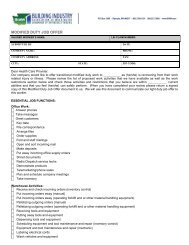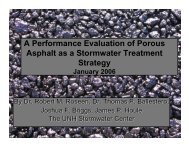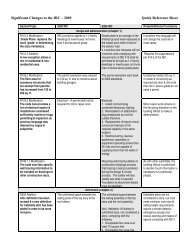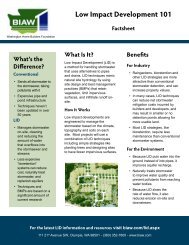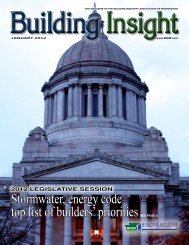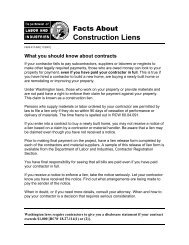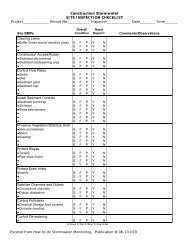SWPPP Template - Building Industry Association of Washington
SWPPP Template - Building Industry Association of Washington
SWPPP Template - Building Industry Association of Washington
You also want an ePaper? Increase the reach of your titles
YUMPU automatically turns print PDFs into web optimized ePapers that Google loves.
Stormwater Pollution Prevention Plan<br />
book during construction that no further impacts to pH in the water body<br />
will occur, or that the discharge is consistent with the TDML or control<br />
plan requirements set forth for the specific downstream water body (see<br />
sections S1.D5, S1.D6, and S4.G2 <strong>of</strong> the Construction Stormwater<br />
General Permit).<br />
• Refer to permit section S4.G in Appendix D for sampling procedures and<br />
guidance manual references.<br />
• The following provides an example text section based on a pH TMDL <strong>of</strong><br />
8.0. Each site will have site-specific monitoring and compliance standards<br />
based on the water body parameter(s) <strong>of</strong> concern, applicable basin plan, or<br />
TMDL. This is only an example. The applicant is required to insert site<br />
specific text in the area labeled “REQUIRED TEXT”.<br />
EXAMPLE TEXT<br />
6.2.2 pH<br />
Sampling and monitoring for pH will occur during the phase <strong>of</strong> construction when concrete<br />
pouring will be conducted until fully cured (3 weeks from pour). Samples will be collected<br />
weekly at the sedimentation pond prior to discharge to surface water. Samples will be analyzed<br />
for pH using a calibrated pH meter and recorded in the site log book.<br />
The key benchmark pH value for stormwater is a maximum <strong>of</strong> 8.0. If a pH greater than 8.0 is<br />
measured in the sedimentation pond that has the potential to discharge to surface water, the<br />
following steps will be conducted:<br />
1. Assess whether additional BMPs should be implemented and whether<br />
associated revisions to the <strong>SWPPP</strong> are necessary<br />
2. Stop (detain) all discharges from leaving the site and entering surface<br />
waters or storm drains if the pH is greater than 8.5<br />
3. Sample sedimentation pond the following day, and if the pH exceeds 8.0<br />
for the second consecutive day, implement CO 2 sparging treatment<br />
4. Sample and measure pH daily until there are 3 consecutive pH<br />
measurements less than 8.0.<br />
5. If there are 3 consecutive pH measurements greater than 8.0, notify<br />
Ecology by phone within 24 hours <strong>of</strong> the 3 rd measurement exceeding a pH<br />
<strong>of</strong> 8.0 (see Section 5.0 <strong>of</strong> this <strong>SWPPP</strong> for contact information) and initiate<br />
discussions with Ecology regarding additional treatment BMPs.<br />
30




